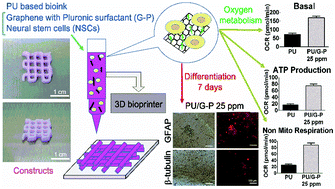当前位置:
X-MOL 学术
›
J. Mater. Chem. B
›
论文详情
Our official English website, www.x-mol.net, welcomes your
feedback! (Note: you will need to create a separate account there.)
A graphene–polyurethane composite hydrogel as a potential bioink for 3D bioprinting and differentiation of neural stem cells
Journal of Materials Chemistry B ( IF 6.1 ) Pub Date : 2017-11-06 00:00:00 , DOI: 10.1039/c7tb01594a Chao-Ting Huang,Lok Kumar Shrestha,Katsuhiko Ariga,Shan-hui Hsu
Journal of Materials Chemistry B ( IF 6.1 ) Pub Date : 2017-11-06 00:00:00 , DOI: 10.1039/c7tb01594a Chao-Ting Huang,Lok Kumar Shrestha,Katsuhiko Ariga,Shan-hui Hsu

|
3D bioprinting is known as an additive manufacturing technology that builds customized structures from cells and supporting biocompatible materials for the repair of damaged tissues or organs. In this study, we prepared water-dispersible graphene and graphene oxide, which are 2D nanomaterials with high conductivity and potential applications in neural tissue engineering. Moreover, we synthesized a new biodegradable waterborne polyurethane with soft segments that mostly contained poly(ε-caprolactone) (2 kDa) and 20 mol% of shorter (1.5 kDa) poly(D,L-lactide) chains. This polyurethane dispersion at a solid content of 25% in a cell culture medium underwent a sol–gel transition near human body temperature with a suitable gel modulus. After this, we mixed graphene or graphene oxide with polyurethane to prepare a graphene-based nanocomposite hydrogel for neural stem cell (NSC) printing. The rheological properties of the graphene-based nanocomposite hydrogel were suitable for the printing and survival of NSCs. Furthermore, the addition of a very low content (25 ppm) of graphene nanomaterials to the hydrogel significantly enhanced the oxygen metabolism (2- to 4-fold increase) as well as the neural differentiation of NSCs. In summary, the graphene–polyurethane nanocomposite hydrogel may be a possible bioink for printing 3D cell-laden tissue constructs for neural tissue engineering.
中文翻译:

石墨烯-聚氨酯复合水凝胶可作为神经干细胞的3D生物打印和分化的潜在生物墨水
3D生物打印是一种增材制造技术,可从细胞构建定制结构并支持生物相容性材料,以修复受损的组织或器官。在这项研究中,我们制备了水可分散的石墨烯和氧化石墨烯,它们是具有高电导率的二维纳米材料,在神经组织工程中具有潜在的应用前景。此外,我们合成了一种新型的可生物降解的水性聚氨酯,其软段主要包含聚(ε-己内酯)(2 kDa)和20摩尔%的较短(1.5 kDa)聚(D,L-丙交酯)链。这种聚氨酯分散液在细胞培养基中的固含量为25%,在接近人体温度的条件下以合适的凝胶模量经历了溶胶-凝胶转变。之后,我们将石墨烯或氧化石墨烯与聚氨酯混合,以制备用于神经干细胞(NSC)印刷的基于石墨烯的纳米复合水凝胶。石墨烯基纳米复合水凝胶的流变特性适用于NSC的印刷和存活。此外,向水凝胶中添加极低含量(25 ppm)的石墨烯纳米材料可显着增强氧代谢(增加2至4倍)以及神经干细胞的神经分化。总而言之,石墨烯-聚氨酯纳米复合水凝胶可能是用于打印3D细胞的组织结构以用于神经组织工程的一种生物墨水。
更新日期:2017-11-15
中文翻译:

石墨烯-聚氨酯复合水凝胶可作为神经干细胞的3D生物打印和分化的潜在生物墨水
3D生物打印是一种增材制造技术,可从细胞构建定制结构并支持生物相容性材料,以修复受损的组织或器官。在这项研究中,我们制备了水可分散的石墨烯和氧化石墨烯,它们是具有高电导率的二维纳米材料,在神经组织工程中具有潜在的应用前景。此外,我们合成了一种新型的可生物降解的水性聚氨酯,其软段主要包含聚(ε-己内酯)(2 kDa)和20摩尔%的较短(1.5 kDa)聚(D,L-丙交酯)链。这种聚氨酯分散液在细胞培养基中的固含量为25%,在接近人体温度的条件下以合适的凝胶模量经历了溶胶-凝胶转变。之后,我们将石墨烯或氧化石墨烯与聚氨酯混合,以制备用于神经干细胞(NSC)印刷的基于石墨烯的纳米复合水凝胶。石墨烯基纳米复合水凝胶的流变特性适用于NSC的印刷和存活。此外,向水凝胶中添加极低含量(25 ppm)的石墨烯纳米材料可显着增强氧代谢(增加2至4倍)以及神经干细胞的神经分化。总而言之,石墨烯-聚氨酯纳米复合水凝胶可能是用于打印3D细胞的组织结构以用于神经组织工程的一种生物墨水。











































 京公网安备 11010802027423号
京公网安备 11010802027423号